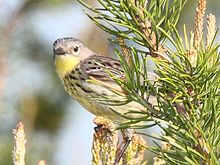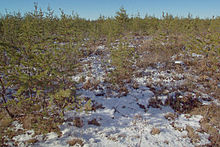- Kirtland's Warbler
-
Kirtland's Warbler 
Male Conservation status Scientific classification Kingdom: Animalia Phylum: Chordata Class: Aves Order: Passeriformes Family: Parulidae Genus: Dendroica Species: D. kirtlandii Binomial name Dendroica kirtlandii
(Baird, 1852)Synonyms Dendroica kirtlandi (lapsus)
Kirtland's Warbler (Dendroica kirtlandii) is a small songbird of the New World warbler family (Parulidae), named after Jared P. Kirtland, an Ohio doctor and amateur naturalist. Nearly extinct just 50 years ago, it is well on its way to recovery. It requires large areas (> 160 acres) of dense young jack pine for its breeding habitat. This habitat was historically created by wildfire, but today is primarily created through the harvest of mature jack pine, and planting of jack pine seedlings.[1]
Since the mid-19th century at least it has become a restricted-range endemic species. Almost the entire population spends the spring and summer in the northeastern Lower Peninsula of Michigan and winters in The Bahamas.
These birds have bluish-brown upper body parts with dark streaks on the back and yellow underparts with streaked flanks. They have thin wing bars, dark legs and a broken white eye ring. Females and juveniles are browner on the back. Like the Palm Warbler and Prairie Warbler, they frequently bob their tails. At 14–15 cm (5.5–5.9 in) and 12–16 g (0.42–0.56 oz), it is the largest of the numerous Dendroica warblers.[2] Their song is a loud chip-chip-chip-too-too-weet-weet often sung from the top of a snag (dead tree) or northern pin oak (Quercus ellipsoidalis) clump.
Contents
Range and ecology
Their breeding range is in a very limited area in the north of the Lower Peninsula of Michigan. They then come to southern Ontario. In recent years, breeding pairs have been found in the Upper Peninsula of Michigan, Wisconsin, and Ontario likely due to the rapidly expanding population. Breeding habitat is typically large areas (> 160 acres) of dense young jack pine (Pinus banksiana). Kirtland's Warblers occur in greatest numbers in large areas that have been clearcut or where a large wildfire has occurred.[1] The birds leave their breeding habitat between August and October and migrate to The Bahamas and nearby Turks and Caicos Islands; they return to Michigan to breed again in May. In their winter habitat, they have been found primarily in scrub habitat, feeding on wild sage, black torch, and snowberry.[3]
Kirtland's Warblers forage in the lower parts of trees, sometimes hovering or searching on the ground. These birds eat insects and some berries, also eating fruit in winter. For breeding they require stands of young (4 to 20 year old, 2–4 m high) Jack Pine trees. They nest on the ground. Their nest is usually at the base of a tree, next to a down log or other structure, and is well concealed by sedge, grasses, blueberries and other ground vegetation.
Habitat
Ecology of Jack Pine
Jack Pines are somewhat smallish pine widespread from the Canadian tundra and taiga to the Great Lakes region and the Atlantic Ocean; they are a boreal species, only occurring in a certain climate.[4] Their cones open only after trees have been cleared away by forest fires or, after logging, in the summer sun. About all of its present-day range was covered by solid ice as late as 10 000 to 15 000 years ago; the range of the pine (and as it seems the warbler also) was probably a contiguous swath between the Appalachian Mountains and the Great Plains. The pine's peculiar reproductive strategy fits well with a dry taiga or cool temperate habitat as would have predominated there, probably with a higher incidence of forest fires than today, as the ice age climate was somewhat drier overall.[5]
Decline to near-extinction
As global climate changed out of the ice age through the last 10 millennia or so, Jack Pine, and consequently also Kirtland's Warbler, shifted their habitat north. As the Kirtland's Warbler—and Parulidae in general—is not able to expand into subarctic climate well, most Jack Pine woods are too far north for the species. Moreover, the Great Lakes, which formed before the receding ice, were an obstacle for its spread. Kirtland's Warbler found itself blocked by the expanse of water, while the cold-hardy Jack Pine expanded its range as far as the Northwest Territories.
With European settlement of North America progressing in earnest, much of the forest in the southern Great Lakes region was cut away, never to be restocked. Kirtland's Warbler became trapped on the Northern Peninsula. It may or may not have occurred in Dr. Kirtland's home state of Ohio in recent times, but if it did it would seem to have been extirpated from the state around the time when its namesake himself died in 1877. What habitat there might have been was cleared away in the latter half of the 19th century, and certainly the bird was not breeding there anymore in 1906.[6] Kirtland's Warblers used to breed in Ontario but have not done so since the 1940s. By the mid twentieth century its numbers had crashed to near-extinction. The Kirtland's Warbler population reached lows of probably less than 500 individuals around the 1970s, and in 1994 only 18 km² of suitable breeding habitat was available.[7]
Recovery
Today this is the bird's habitat is being preserved by controlled or prescribed burns and staggered timber harvests in its limited breeding range. Since this habitat management regime was begun in the 1970s, the birds' numbers have steadily risen, though they are still at dangerously low levels. People have also intervened to protect this bird against nest parasitism by Brown-headed Cowbirds, to which these birds are highly susceptible.
They have still been observed in Ontario and the Upper Peninsula of Michigan, and though it is still only rarely recorded in NW Ohio (where there is hardly any significant woodland left), the numbers of recorded birds are increasing.[8] Beginning in 2005, a small number have been observed in Wisconsin. In 2007, three Kirtland's Warbler nests were discovered in central Wisconsin[9] and one at CFB Petawawa,[10] providing an auspicious sign that they are recovering and expanding their range once again.
The Kirtland's Warbler is listed as "endangered" under the Endangered Species Act of 1973.[11] Although there seem to be no more than 5,000 Kirtland's Warblers as of late 2007,[12] four years earlier they had numbered just 2500–3000. On the IUCN "Red List of Threatened Species," the Kirtland's Warbler was classified as Vulnerable to extinction since 1994, but was downlisted to Near Threatened in 2005 due to its encouraging recovery. It is not clear to what extent the birds depend on Bahamas pine during winter; deforestation on the wintering grounds may eventually become a bigger threat to the birds' recovery than the situation in its breeding range.[7]
The Michigan Department of Natural Resources has recently made optimistic reports about the populations of Kirtland's Warblers.[13]
Recent reports indicate that the population is growing, but also suggest that the Kirtland Warbler may continue to be dependent upon human protection and intervention forever.[14]
There is a Kirtland's Warbler Wildlife Festival, which is sponsored in part by Kirtland Community College (which is named in honor of the bird and its habitat).[15]
See also
Footnotes
- ^ a b Philip W. Huber, Wildlife Biologist, USDA Forest Service
- ^ http://onnaturemagazine.com/kirtland%E2%80%99s-warbler.html
- ^ Scott B. Johnson, pers. comm.
- ^ Peel et al. (2007)
- ^ Ray & Adams (2001)
- ^ Henninger (1906)
- ^ a b BLI (2005)
- ^ OOS (2004)
- ^ USFWS (2007) (2004)
- ^ CFBP (2007)
- ^ U.S. Fish and Wildlife Service Species Profile for Kirtland's Warbler.
- ^ USFWS: Kirtland's Warbler Census Results: 1951–2008.
- ^ Kirtland's Warbler Populations Continue to Grow, Michigan Department of Natural Resources
- ^ Flesher, John, Warbler may be endangered forever, September 21, 2008, Detroit Free Press.
- ^ "Kirtland Warbler Festival and links.". http://warbler.kirtland.edu/.
References
- BirdLife International (BLI) (2005). Dendroica kirtlandii. 2006. IUCN Red List of Threatened Species. IUCN 2006. www.iucnredlist.org. Retrieved on 11 May 2006. Database entry includes a range map and justification for why this species is near threatened
- CFB Petawawa (CFBP) (2007): Canada's Rarest Nesting Bird found at CFB Petawawa. Version of 2007-Nov-01. Retrieved 2008-FEB-19.
- Henninger, W.F. (1906): A preliminary list of the birds of Seneca County, Ohio. Wilson Bull. 18(2): 47-60. DjVu fulltext PDF fulltext
- Mayfield, Harold (1960): The Kirtland's Warbler. Cranbrook Institute of Science Bulletin 40.
- Ohio Ornithological Society (OOS) (2004): Annotated Ohio state checklist. Version of April 2004. PDF fulltext
- Peel, M.C.; Finlayson, B.L. & McMahon, T.A. (2007): Updated world map of the Köppen-Geiger climate classification. Hydrology and Earth System Sciences 11(5): 1633-1644. PDF fulltext Supplement
- Ray, Nicolas & Adams, Jonathan M. (2001): A GIS-based Vegetation Map of the World at the Last Glacial Maximum (25,000-15,000 BP). Internet Archaeology 11. PDF fulltext
- United States Fish and Wildlife Service (USFWS) (2007): Kirtland's Warbler 2007 Nesting Season Summary. Version of 2007-DEC-10. Retrieved 2008-FEB-19.
External links
- Kirtland's Warbler at All About Birds
- Kirtland Warbler Festival and links
- Kirtland's Warbler, Michigan Department of Natural Resources
- The Nature Conservancy Songbirds: Kirtland's Warbler
- Endangered species program, Kirtland's Warbler, US Fish and Wildlife Service
- Stamps
- USDA Huron-Manistee National Forests Kirtland Warbler Page
Categories:- IUCN Red List near threatened species
- New World warblers
- Dendroica
- North American restricted-range endemic bird species
- Birds of Canada
- Birds of the United States
- Birds of the Bahamas
- Birds of the Turks and Caicos Islands
- Endangered fauna of the United States
Wikimedia Foundation. 2010.




